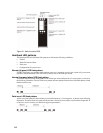
112 Intel Blade Server Fibre Channel Switch Module SBCEFCSW / FC Expansion Card SBFCM Guide
Configuring translated loop (TL) modes (external ports only)
You can configure an external (0,15) TL_Port to support a loop of private target devices or a loop of private
initiator devices.
• For a loop of up to 124 private target devices, click
TL Target. This enables up to 63 initiator devices
anywhere in the fabric to automatically connect with the private devices on the TL_Port. Group the
TL_Port and up to 63 initiators in the same soft or ACL zone using the worldwide name or domain ID and
port ID membership, to limit the number of possible initiators to 63.
• For a loop of up to 125 private initiator devices, click
TL Initiator. This enables the private initiators on
the TL_Port to automatically connect to up to 64 target and initiator devices in the same soft or ACL zone.
You must group the TL_Port and the target devices in the same soft or ACL zone using the worldwide
name or domain ID and port ID membership. If there are more than 65 members in the zone, the TL_Port
is unable to communicate with the fabric.
Changing buffer-to-buffer credits (external ports only)
Each switch module external port (0,15) has a receive buffer capacity of 12 Fibre Channel frames or credits,
which is equal to approximately 24 KB. Port buffer credits can be changed on ports to accommodate
connections to other switch modules that have different port buffer capacities. Complete the following steps to
change external port buffer credits:
1. Select one or more ports in the Faceplate window.
2. Click
Port / Port Properties.
3. In the
E_Port BB Credits field, type the new number.
4. Click
OK to write the new buffer-to-buffer setting to the switch module.
I/O stream guard
The I/O Stream Guard feature suppresses registered state control notification (RSCN) messages on external
ports (0,15).
Extending port credits
Each external port (0,15) is supported by a data buffer with a 12-credit capacity; that is, 12 maximum sized
frames. For fiber-optic cables, this enables full bandwidth class 2 service over a distance of 20 km (12.4 mi) at
1 Gbps (0.6 credits per km), or 10 km (6.2 mi) at 2 Gbps (1.2 credits per km). Longer distances can be spanned
at full bandwidth by borrowing credits from designated donor ports; therefore, pooling the buffer capacities.
This is called credit extension. Each donor port contributes 11 credits to the pool from which the recipient
ports can draw. Only external ports (0,15) can be donor or recipient ports. For example, one donor port
contributes 11 credits to the pool from which a recipient draws for a total of 23 credits (11+12). This provides
approximately 38 Km (23.6 mi) at 1 Gbps (23÷0.6) or 19 km (11.8 mi) at 2 Gbps (23÷1.2).
Complete the following steps to extend port buffer credits:
TL_Port Translated loop port - Supports a loop of up to 124 private target devices or 125
private initiator devices capable of communicating with up to 63 off-loop initiator
devices or 64 off-loop target devices.
G_Port Generic port - Self-discovers as an F_Port or an E_Port.
GL_Port Generic loop port - Self-discovers as an F_Port, FL_Port, or an E_Port.
Donor Donor port - Allows buffer credits to be used by another port.
Table 32. Port modes (continued)
State Description


















